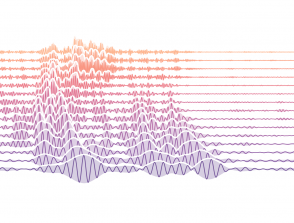Détection, Localisation and caracterisation of Very Low Frequency (VLF) events in the sismo-volcanic crisis in Mayotte (2018-2022)
Start: 01 October 2019
End: 14 April 2023
Supervisors :
Pascal Bernard, Claudio Satriano
Related teams :
Seismology, Sismologie
Status: Defended
Low frequency transient seismic signals are observed in volcanic context and reflects the dynamics of internal fluids inside the magmatic systems.
Their study provides information on the state of the internal stresses and magmatic processes among which fluid transfers and resonances are involved.
On November 11, 2018, a unique and atypical 15 s monochromatic signal is worldwide recorded. This Very Low Frequency (VLF) signal is first interpreted as surface waves of volcanic origin, then as the migration of fluids in a pressurized conduit. It’s signal originates from Mayotte island located in the Mozambique Channel (Indian Ocean) which separates Africa from Madagascar. Mayotte is the oldest volcanic island of the Comoros archipelago where the Karthala volcano remains active (Grande Comore), but whose the origin of volcanism is complex and still debated.
The November 11, 2018 major event isn’t an isolated case. Our catalog contains more than 750 similar events which are part of the seismic crisis initiated on May 10, 2018 at 50 km eastern coast of Mayotte. Where a new volcanic edifice of 6.55 km3, named Fani Maoré, was discovered by bathymetric surveys during the marine campaign (R/V Marion Dufresne) in May 2019.
What is the physical phenomenon that produces VLF events? What information What information provides their seismic analysis on the state, geometry and volume of the storage zones located in the complex structure of the magmatic system of Mayotte?
This thesis is an in-depth study of VLF magmatic signals specific to the context of the seismo-volcanic crisis of Mayotte. Tracing their origin is part of the general understanding of the dynamics of the Mayotte magmatic system reactivated since May 2018.
The phenomenological analysis starts with the construction of a specific detector for VLF events based on the 15 s dominant spectral peak and the long decaying oscillation of the signals (up to more than 3000 seconds/50 minutes ). Then, a 3D spatial back-projection localization method is developed taking into account their unconventional character. Finally, a characterization based on the local network waveform inter-correlation is carried out, supported by the OBH [Ocean Bottom Hydrophones] deployed during the oceanographic campaigns supervised by the REVOSIMA [Réseau de Volcanological and Seismological Monitoring of Mayotte]. The detection, localization and seismic characterization of VLF events provide information on the source involved.
VLF events are spatially located within the 15 km east proximal seismic activity but temporally they are precursors to it. The depth, poorly constrained, will be decisive to trace the source at the origin of the VLF events in the complex magmatic system of Mayotte. The reduction of the depth uncertainties will become the second challenge of this thesis.
First, by the teleseismic modelling of the waveform, then, at the local scale, with the contribution of the OBHs, an exploration of the space of the hypocenters and the different types of source is carried out.
The focal mechanism includes a non-negligible proportion of CLVD, meaning that a volumetric source inducing a non-brittle fracture dynamics produces VLF events. The source at the origin of the VLFs is located at intermediate depths, between the magmatic underplating equivalent to the MOHO and the seismicity. The physical phenomenon is then interpreted as the movements of fluids in resonance in a magmatic lens reactivated by the seismic crisis of Mayotte and the birth of the Fani Maoré.





